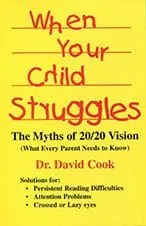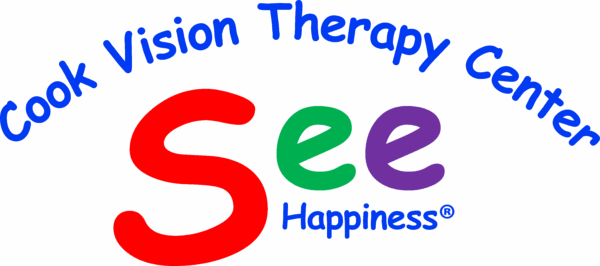Vision, Reading, and Dyslexia Evaluation
Why Does Your Bright Child Struggle with Reading and Writing?
Is there an undetected visual perceptual or eye-coordination problem causing or contributing to the reading problem? Does your child have dyslexia? Will glasses or vision therapy help your child read better? Is it a problem breaking a stream of sound into its parts (phonemic awareness)? Can your child listen to you read for an hour but struggle to look at print for 10 minutes (convergence insufficiency/general binocular dysfunction)? Does your child have visual processing difficulties, such as reversing letters like “b” and “d”? Does your child lack the ability to create images in the mind’s eye (aphantasia)? Does your child have poor eye-hand coordination or lags in the development of visual motor integration? Are visual/spatial challenges magnifying the severity of dyslexia?
At Cook Vision Therapy Center, these and more are the questions we’ve been asking and helping to answer for over forty years. Our success depends not on enhancing just visual abilities but seeing that these abilities transfer to reading and writing.
To do so, we also work with parents, schools, reading specialists, occupational therapists, speech and language specialists, and educational psychologists. Reading is complex. But as our testimonials suggest, sometimes a simple answer can produce a profound result.

Call for a free phone consultation to see if you are a good candidate for our vision/reading/dyslexia approach.
Our Evaluation Will Explore the Following Areas:
Visual Interference with Reading
-
Case History
Used by the doctor for clues on the nature of the reading problem. -
Eyeglasses Requirement
Determine any need for eyeglasses for better vision and reading comfort. -
Eye Coordination Problems
Assess issues like discomfort, fatigue, visual confusion, or difficulty in the detailed seeing needed for reading. -
Visual Attention and Tracking Problems
Determine difficulties in aiming eyes correctly, maintaining fixation, or aligning eyes and attention on individual words or parts of words. -
Visual Processing Deficits
Identify problems like letter reversals (e.g., confusing “b” and “d”) that interfere with reading. -
Eye-Hand Coordination Problems
Evaluate any issues that affect handwriting, using tests like the Beery Test of Visual Motor Integration and the Detroit Test of Learning Aptitude. -
Visualization Skills
Assess if visualization is being used effectively to “see” words and parts of words in the mind’s eye. -
Dyslexia Screening
- Phonemic Awareness: Evaluate the ability to hear individual sounds in a word, which is essential for learning phonics.
- Automatic Naming: Assess how quickly a child can recognize symbols and produce the correct name or sound.
- General Status of Decoding Skills: Evaluate overall ability to decode and read words effectively.
Detailed Description of Evaluation
CASE HISTORY
Your first step is to complete a case history form to provide the doctor with clues on ways vision may be impacting reading.
EYESIGHT
Visual Acuity Explained (Reference: When Your Child Struggles, Chapter 2)
-
20/20 Vision Basics: Clear sight at 20 feet (e.g., classroom whiteboards) or for short tasks like reading a few letters.
-
Key Limitation: While 20/20 acuity ensures brief clarity, it doesn’t guarantee sustained focus during reading—critical for Cobb County homework or extended screen time.
Refractive Error & Marietta Kids (Reference: Chapters 3 & 4)
-
What It Means: Determines lens strength needed for crisp distance vision (e.g., seeing road signs on GA-120 or sports fields).
-
Local Impact: Untreated refractive errors strain focus during activities like virtual learning or after-school programs common in Marietta.
Advanced Eye-Muscle Coordination Testing in Marietta, GA
(Reference: When Your Child Struggles, Chapters 6 & 7)
Why Eye Coordination Matters for Cobb County Students
Fourteen eye muscles work together to maintain clear, stable vision. Poor coordination can lead to:
-
Eyestrain, headaches, or double vision (even with 20/20 acuity).
-
Reading struggles: Loss of focus, frequent rereading, or trouble recalling text.
-
Learning challenges: Critical for kids with reading disabilities in Marietta schools.
Local Impact:
-
High-demand tasks (e.g., advanced textbooks at Pope High School or STEM projects) require precise coordination.
-
Fatigue from poor coordination worsens with complex material, slowing progress in Cobb County classrooms.
Specialized Tests at Our Marietta Clinic
We perform 15+ advanced tests rarely included in standard exams:
- Cover Test: Detects eye misalignment (strabismus/phoria).
- Near Point of Convergence: Measures close-range coordination for tasks like homework.
- Stereopsis: Assesses depth perception (key for sports or art classes).
- Worth Four Dot: Identifies double vision or suppression.
- Stereoscope & Randot Stereograms: Evaluate convergence/divergence for screen use (common in virtual learning).
- Prism/Lens Tests: Gauge flexibility under stress (e.g., vergence facility).
-
Visual Attention & Eye Movement
What Is Visual Attention?
The skill of directing eyes precisely at targets (e.g., words on a page or classroom whiteboards). Poor accuracy forces reliance on peripheral vision, leading to blurred or confused information.
Why It Matters for Cobb County Kids
-
Impacts reading fluency, homework focus, and participation in activities like Marietta Little League or art classes.
-
Critical for classroom tasks: Following teachers’ pointers, solving math problems, or taking notes.
How We Test in Marietta
-
Moving Light Fixation: Measures the ability to track a moving target (mimics tracking words across a page).
-
Age-Based Benchmarks:
-
Under 5: Struggles to focus without head movement (common in Marietta preschoolers).
-
Age 5: Focuses but uses head/face muscles (typical for Cobb County kindergartners).
-
Ages 6-7: Focuses without head movement but requires full concentration (key for 1st–2nd grade reading).
-
Ages 8+: Maintains focus while multitasking (e.g., math drills at Marietta’s Sawyer Road Elementary).
-
VISUAL TRACKING(See Chapter 8 of When Your Child Struggles)
Visual tracking is the ability to move the eyes along a line of print. We evaluate the skill with the King Devick Visual Tracking Test. The test uses numbers rather than words so we can tell how much of a tracking problem is due to eyes and how much is due to language skills. In other words, we are trying to determine if poor spatial awareness is causing loss of place when reading and decoding or if there a language problem causing confusion and loss of place. Some readers suffer from one problem or the other. Some suffer from both.
Visual Perception
(See Chapter 9 of When Your Child Struggles)
What Is Visual Perception?
The ability to distinguish shapes, letters, and words (e.g., “b” vs. “d” or “was” vs. “saw”). Critical for reading fluency in Cobb County classrooms, where letter reversals or word confusion can slow progress.
Why It Challenges Young Learners
-
Young kids often see symbols like “b” and “d” as identical due to directional focus (“outward” vs. “inward”).
-
Spatial awareness of right/left must develop before memory tricks (e.g., “bed” hand gestures) work effectively.
Local Impact in Marietta Schools
-
Struggles with visual perception can lead to frustration in subjects like spelling at Sawyer Road Elementary or reading at Marietta Sixth Grade Academy.
-
Delays may affect performance in activities like Cobb County library reading programs or homework assignments.
HAND-EYE COORDINATION
(See Chapter 10 of When Your Child Struggles)
How well do your child’s eyes guide his hands and body? If the eyes do not properly guide the hands, then learning to write is difficult despite proper instruction. Catching a ball or learning to ride a bike may be difficult.
If hand-eye coordination is difficult, one step is to insure that good visual attention, perception, and eye-muscle coordination allow the patient to use vision to guide the hands. Another step is to insure that the eyes and hands are coordinated with one another. We evaluate fine motor coordination using the Motor Speed and Precision Subtest of the Detroit Test of Learning Aptitude. We evaluate visual motor integration using the Beery Test of Visual Motor Integration.
VISUALIZATION
(See Chapter 11 of When Your Child Struggles)
What Is Visualization?
The ability to mentally create images, such as:
-
Spelling HOUSE backward.
-
Transforming CAT to FIN by swapping letters.
-
Picturing a cowboy scene from words like COWBOY or HORSE.
Why It Matters for Cobb County Readers
-
Helps decode challenging words (e.g., saw vs. was).
-
Builds comprehension for complex texts used in Marietta schools.
-
Supports spelling and creative problem-solving.
How We Test in Marietta
-
Informal Exercises: Simulate classroom tasks (e.g., mental word manipulation).
-
Monroe III Test: Measures detail retention for advanced reading skills.
READING SCREENING
We do not assess which exact decoding skills are missing. We will not, for instance, determine if your child knows that the eigh in neighbor and weigh makes the “long A sound.” We will not assess the exact vocabulary skills of your child. If your child easily understands when being read to, vocabulary is less likely a problem. If your child does not understand when read to, you will need a language evaluation as well. We will instead look at some skills commonly missing in children who do not “teach themselves” to read during a standard reading program.
Phonemic Awareness
Phonemic Awareness the ability to break down a stream of sound into its parts. If you cannot recognize the sounds in a word, it is difficult to match symbols (letters) with those sounds. Test questions for this area may include such commands as “Say ‘steamboat.’ Now say it again but don’t say ‘boat.’” “Say ‘pick.’ Now say it again but don’t say ‘p’ [make p sound].” Or “Say ‘scat.’ Now say it again but don’t say ‘C’ [make k sound].” We assess phonemic awareness using the Rosner Test of Visual Analysis Skills. The test examines the basic types of phonemic awareness skills necessary for learning phonics. Different skills are expected in kindergarten, first, second, and third grade.
Automatic Naming
What Is Automatic Naming?
The ability to quickly recognize symbols (like letters/numbers), recall their names/sounds, and produce them aloud.
Impact on Cobb County Students
-
Reading Aloud Struggles: Slows fluency, common in dyslexia.
-
Phonics Challenges: Makes “sounding out words” harder.
-
Workarounds: Visualization strengthens sight vocabulary (e.g., picturing HOUSE instead of sounding it out repeatedly).
Why It Matters for Marietta Families
-
Repetitive phonics struggles (e.g., rereading the same word) may signal:
-
Poor eye teaming (common in vision-related reading issues).
-
Weak visualization skills.
-
Perception challenges.
-
How We Test in Marietta
-
King-Devick Tracking Test (Section 1): Uses number sequences connected by lines to isolate rapid symbol naming from tracking skills.
Informal Oral Reading
Dr. Cook listens to paragraphs read from the Gates Oral Reading Test. He looks for an approximate word-calling level and for what types of errors are made. Sometimes he checks how using a pointer to maintain accurate fixation helps. He checks how covering one eye affects reading: does the child’s reading improve when not having to coordinate two eyes? He is interested in gaining a feel for both basic reading skills and how vision is affecting reading.
Summary
When the evaluation is complete, Dr. Cook will go over the results with the parent or parents. If vision therapy is likely to improve reading performance, he will suggest that a consultation be arranged during which both parents, if possible, to go over a written report and get their questions answered.
Is there an undetected visual perceptual or eye-coordination problem contributing to the reading issue? Could your child’s struggle be related to amblyopia vision therapy or need targeted amblyopia exercises? For those with convergence insufficiency, sustaining focus on text can be a challenge despite interest. Visual processing difficulties, such as letter reversals or poor eye-hand coordination, may also play a role.
At Cook Vision Therapy Center, we address these questions and more, aiming to improve both visual skills and reading comprehension.
FAQs: Vision, Dyslexia, and Learning
-
Can vision therapy “cure” dyslexia?
While dyslexia is a lifelong condition, correcting vision issues (e.g., eye teaming) can reduce its severity and boost confidence.
-
What’s convergence insufficiency?
-
How long does evaluation take?
-
Why does my child struggle with reading despite having 20/20 vision?
-
How do visual processing difficulties impact reading?
-
Can vision therapy help children with dyslexia?
-
What tests diagnose convergence insufficiency in children?
-
How does poor phonemic awareness affect reading?
-
Will glasses improve my child’s reading ability?
-
Why does my child reverse letters like ‘b’ and ‘d’?
-
How does visualization influence reading comprehension?
-
What’s included in a Cook Vision Therapy evaluation?
Check Out Our Resources
Dr. Cook’s Publications:
- Authored books VISUAL FITNESS and WHEN YOUR CHILD STRUGGLES.
- Published articles in top optometric journals.
- His article “Eyesight, infinity and the human heart” was voted “Best Non-Technical Article” by the Association of Optometric Editors.





